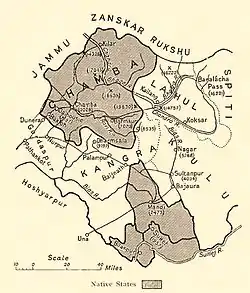The Hill States of India were princely states lying in the northern border regions of the British Indian Empire.
History
| Princely state |
|---|
| Individual residencies |
| Agencies |
|
| Lists |
During the colonial Raj period, two groups of princely states in direct relations with the Province of British Punjab became part of the British Indian Empire later than most of the former Mughal Empire, in the context of two wars and an uprising.
For its princely rulers the informal term Hill Rajas has been coined. It does not apply to other native hill country princes such as the Rawat of Rajgarh.
After the independence and split-up of British India, the Hill States acceded to the new Dominion of India and were later divided between India's constituent states of Punjab (proper), Haryana and Himachal Pradesh.
Simla Hills

28 princely states (including feudatory princes and zaildars) in the promontories of the western Himalaya were named after Shimla as the Simla Hill States.[1] These states were ruled mainly by Hindu Rajputs.[2][3]
Three quarters of the about 4,800 square miles (12,000 km2), on both sides of the Sutlej river, was the territory of the Raja (earlier Rana) of Bashahr. The direct tributaries of Bashahr were :
- the Thakur of Khaneti
- the Thakur of Delath
Initially both Khaneti and Delath were feudatory of Kumharsain.
The other, all far smaller, princely states, including a few with some petty dependencies of their own, were further south, on the left bank of the Sutlej :
- the Rana (also styled as Rana Saheb) of Kumharsain. Tributaries of Kumharsain until 1815 were:
- the Rana of Balsan
- the Thakur of Madhan
- the Thakur of Bharauli
- the Thakur of Beja State
- the Rana of Bhaji /Bhajji
- a prince of Bhagat
- the Raja of Bilaspur (formerly Kahlur/Kehloor), entitled to an 11-guns salute
- the Rana of Darkoti
- the Rana (Shri) of Dhami
- the Raja (formerly Rana) of Jubbal, which had two tributaries:
- the Thakur (sahib) of Dhadi State, initially tributary to Tharoch, then to Bashahr and finally in 1896 to Jubbal.
- (title?) Rawin = Rawingarh
- the Raja (formerly Rana) of Keonthal, where the feudal pyramid included five zaildars (jagirdars collecting a special tax) :
- the Thakur of Kunihar
- the Rana of Kuthar
- the Thakur of Mahlog
- the Rana of Mangal
- the Raja of Nalagarh
- the Thakur (or Rai Mian) of Sangri State
- the Thakur (originally titled Rana up to the occupation by the Gurkhas; Thakurs from 1815 to 1929) of Tharoch = Tiroch
NB - For various of the entities above, the authentic title of the chieftain is missing. While some of the lowest ranking may have had none, for the princes that can merely be due to insufficient sources available
The princely states of the Simla Hills all ultimately became part of the modern Indian state of Himachal Pradesh.
States of the Punjab Hills
Some nearby Hindu and Sikh states include :
References
- ↑ Imperial Gazetteer of India, v. 8, p. 233.
- ↑ "Part I: Kangra (1883-1884)", Gazetteer of the Kangra District, 1883-84; reprinted Indus Publ. Co., New Delhi, 1994, p. 33. ISBN 8173870241
- ↑ Crill, Rosemary; Jariwala, Kapil (2010). The Indian Portrait, 1560-1860. Mapin Publishing Pvt. ISBN 9788189995379.
Sources and external links
- Indian Princely States website
- Punjab State Gazetteer [then Punjab was much larger], vol. VIII, Gazetteer of the Simla Hill States 1910
- Himachal Pradesh State's official website and various links therefrom (click on map or names) to official sites of the state's districts